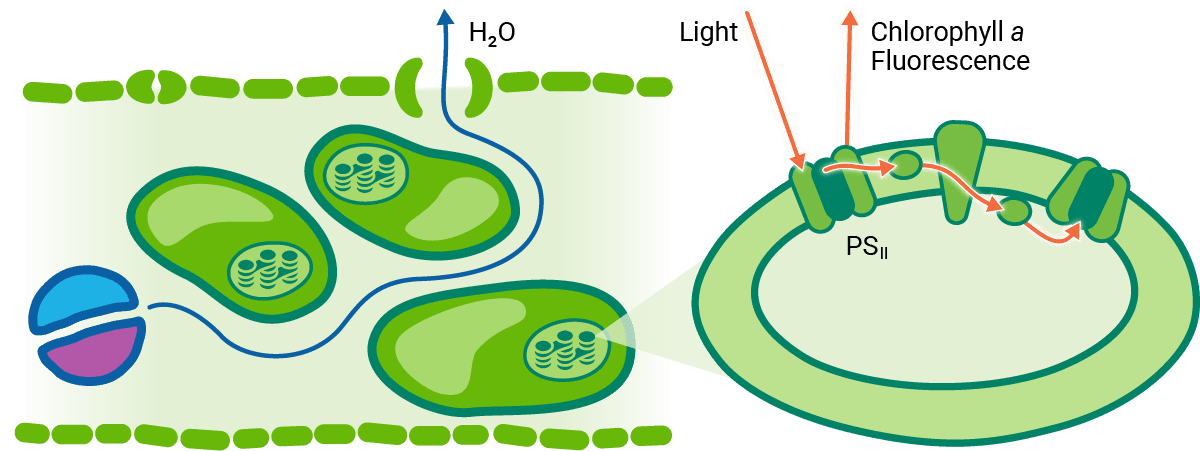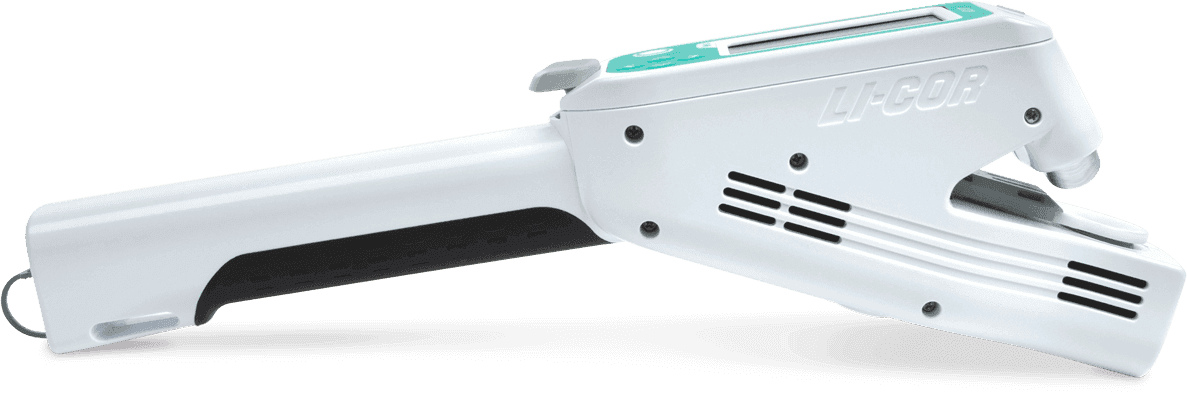Get rapid insights into stomatal conductance, chlorophyll fluorescence, and leaf angle for a variety of leaf sizes and morphologies, including many needles and narrow grasses.
Get a QuoteThe LI-600 and LI-600N are compact porometers with Pulse-Amplitude Modulation (PAM) fluorometers that simultaneously measure stomatal conductance and chlorophyll a fluorescence over the same leaf or needle area. A GPS receiver tracks location and an accelerometer/magnetometer records data needed to calculate a leaf's angle of incidence to the sun. Capable of completing these measurements in seconds, the LI-600 and the LI-600N deliver speed and precision.

Explore the science behind leaf-level gas exchange in our new podcast series, Leaf to Leaf: A Plant Phys Podcast. Each episode dives into the theory, methods, and biology of plant science, paired with chapters from the new book A Hitchhiker's Guide to Leaf-Level Gas Exchange by Jason Hupp and Dr. Richard Vath.
Listen NowCombined measurements of stomatal conductance and chlorophyll a fluorescence present a more complete picture of a plant's physiological state than either technique alone.
Stomatal openings regulate the exchange of water vapor and CO2 between a leaf and the air. Stomatal conductance to water (gsw), which responds to light, CO2, temperature, and humidity, among others, is a measure of the degree of stomatal openness and the number of stomata. It is an indicator of a plant's genetic makeup and physiological response to environmental conditions.
Measurements of chlorophyll a fluorescence can provide information about the leaf's quantum efficiency, electron transport rate (ETR), non-photochemical quenching (NPQ), as well as an assortment of reactions that collectively protect a leaf when it absorbs excessive light energy.

Understanding these processes is important to many research applications, including genetic screening, agronomy, plant physiology, ecology, climate change research, and stress tolerance.
Measurements of chlorophyll a fluorescence provide insights into photosynthesis, and, when combined with stomatal conductance, results in a more complete picture of the overall plant physiology and health. In addition to rectangular flashes, the LI-600 and LI-600N support multiphase flashes (MPF), which can prevent underestimation of Fm' (Loriaux et al., 2013) and thereby reduce bias in numerous fluorescence parameters.
Loriaux SD, et al. (2013). Closing in on maximum yield of chlorophyll fluorescence using a single multiphase flash of sub-saturating intensity. Plant Cell Environ 36:1755-1770.
For light-adapted leaves, the LI-600 and LI-600N measure the quantum yield of fluorescence (ΦPSII), or the proportion of light absorbed by PSII used in biochemistry.

Fm' is maximum fluorescence yield in a light-adapted leaf; Fs is steady-state fluorescence yield in a light-adapted leaf.
For dark-adapted leaves, the LI-600 measures maximum quantum yield (Fv/Fm), or the maximum proportion of absorbed light that can be used to drive photochemistry.

Fv is variable fluorescence yield in a dark-adapted leaf; Fm is maximum fluorescence yield in dark-adapted leaf; Fo is minimum fluorescence yield in a dark-adapted leaf.
The LI-600 and LI-600N measure heading, pitch, and roll, and record latitude, longitude, and altitude. With these data, the LI-600/LI-600N software calculates a leaf's angle of incidence.
The angle of incidence of a leaf– its orientation to the sun at a given time and place–is a useful variable for understanding a plant's architecture and its physiological responses to the environment. A leaf's angle of incidence may change, for example, to maximize light intensity for photosynthesis, minimize light intensity to conserve water, or allow light through a canopy to lower leaves. Knowing the angle of incidence of a leaf can lead to insights into how light intensity drives photosynthesis, and into the differences in measurements taken on the same plant.
The accelerometer/magnetometer measures three variables–heading, pitch, and roll–and the GPS receiver records leaf location and solar position. The LI-600/LI-600N software uses these data to calculate the angle of incidence for each leaf measurement, allowing researchers to evaluate a plant's environmental status more thoroughly.

The LI-600 records your position using GPS data when a measurement is taken, giving you the ability to track locations and return to specific areas over time. The LI-600 records the date, time, latitude, longitude, and altitude of each measurement, and works with the accelerometer/ magnetometer to record the data needed to calculate a leaf's angle of incidence.
What drives one plant to thrive, and another to fail? How do you measure an entire field? Learn more by digging into soil flux measurements to study soil-plant dynamics. Automate and scale-up to the field with an eddy covariance system. Learn more about LI-COR ecosystem monitoring solutions.
Learn moreYou can configure the LI-600 and LI-600N with ease – just set a few parameters in the computer software and you are ready to collect data. Each LI-600/LI-600N can store up to four configurations, making it easy to switch from one protocol to another. You can save numerous configurations on your Mac or PC and share configuration files with colleagues. Configurations are easily loaded from the software onto the device through a USB connection.
Whether you are preparing for measurements, evaluating data files, or verifying the calibration, the computer software presents a simple, intuitive interface that lets you focus on the task at hand.
The instrument display provides navigation prompts and information that matters without distractions, so you can keep moving from sample to sample. You can view live data, the most recent measurement, configuration settings, GPS satellite fix, and more.
The LI-600 and LI-600N are ideal for high-speed stomatal conductance measurements on many plants in ambient conditions. In contrast, the LI-6800 Portable Photosynthesis System can characterize carbon assimilation and numerous other parameters under controlled chamber or ambient conditions.
When used together, the instruments provide highly complementary data. For example, the LI-600 and LI-600N can be used to screen a large population and the LI-6800 can be used to measure selected individuals from that population in greater detail.
 LI-600 LI-600 |  LI-6800 LI-6800 |
|---|---|
| Rapidly screen up to 200 samples per hour to identify candidates for detailed measurements | Measure detailed physiological and photosynthetic parameters, including light response curves and A/Ci curves |
| Measurements in ambient conditions | Measurements in controlled conditions; capable of multiple independent controls, including light, CO2, H2O, and temperature |
| Easy to use, basic configuration options | Sophisticated configuration options in an intuitive graphical interface |
| Chlorophyll a fluorescence in ambient light | Chlorophyll a fluorescence with controlled light; capable of induction kinetics measurements |

Read an application note with case studies describing how the LI-600 and LI-6800 work together.
Read the app noteRead an application note with case studies describing how the LI-600 and LI-6800 work together.
Read the app noteAccelerate your research
Get a Quote